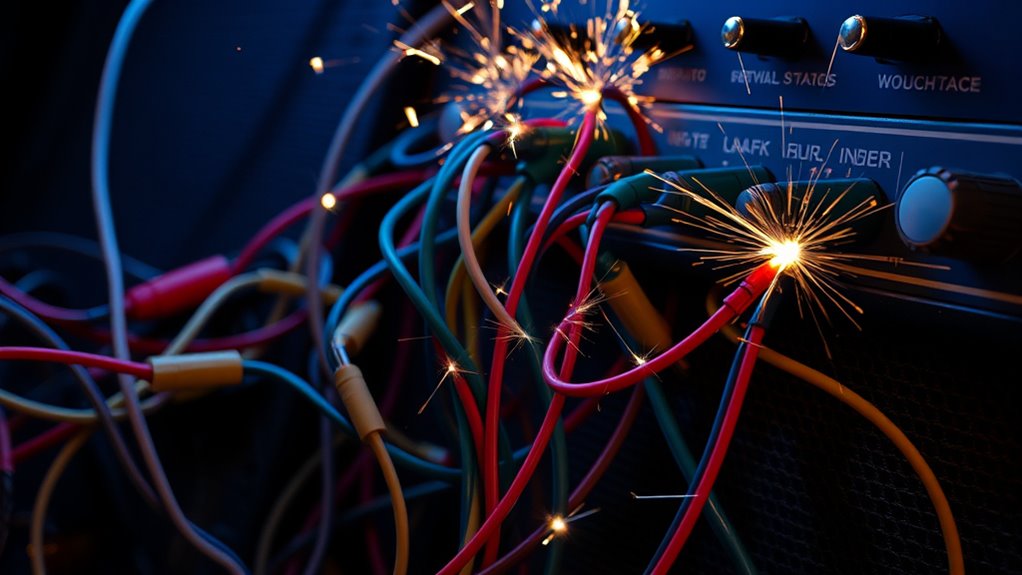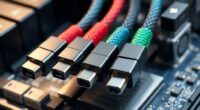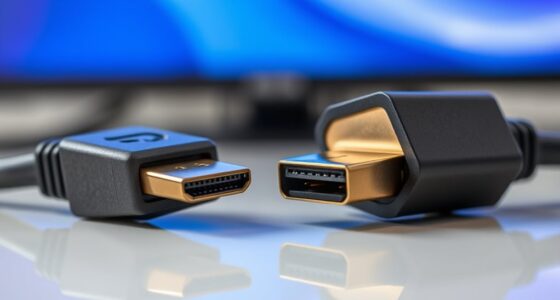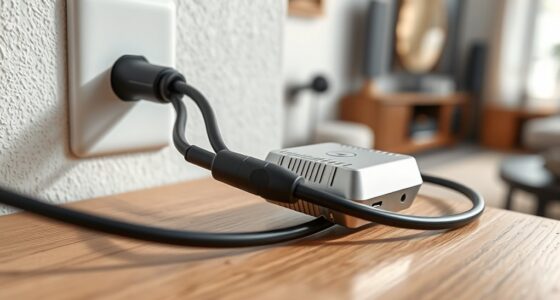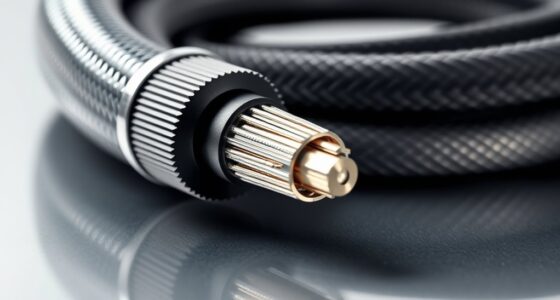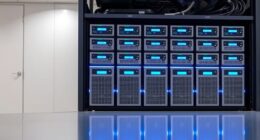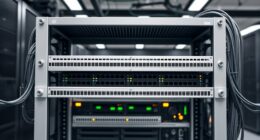Electromagnetic interference (EMI) can cause your audio cables to pick up unwanted hums, static, and buzzes, reducing sound clarity and fidelity. EMI often results from ground loops or nearby electromagnetic fields, which induce noise into your signals. Poor shielding or cable management makes your system more vulnerable. To minimize these issues, make certain of proper grounding, use shielded cables, and keep cables away from noise sources. Continue exploring to discover ways to further protect your audio setup from EMI.
Key Takeaways
- EMI introduces unwanted noise like hums, static, and buzzes, degrading audio clarity and fidelity.
- Poorly shielded or damaged cables allow electromagnetic fields to induce noise into audio signals.
- Ground loop issues caused by multiple ground potentials create circulating currents that produce audible interference.
- Proper cable placement and separation from electromagnetic sources reduce susceptibility to EMI-related noise.
- Using high-quality, well-shielded cables and ensuring proper grounding minimizes EMI impact on audio performance.
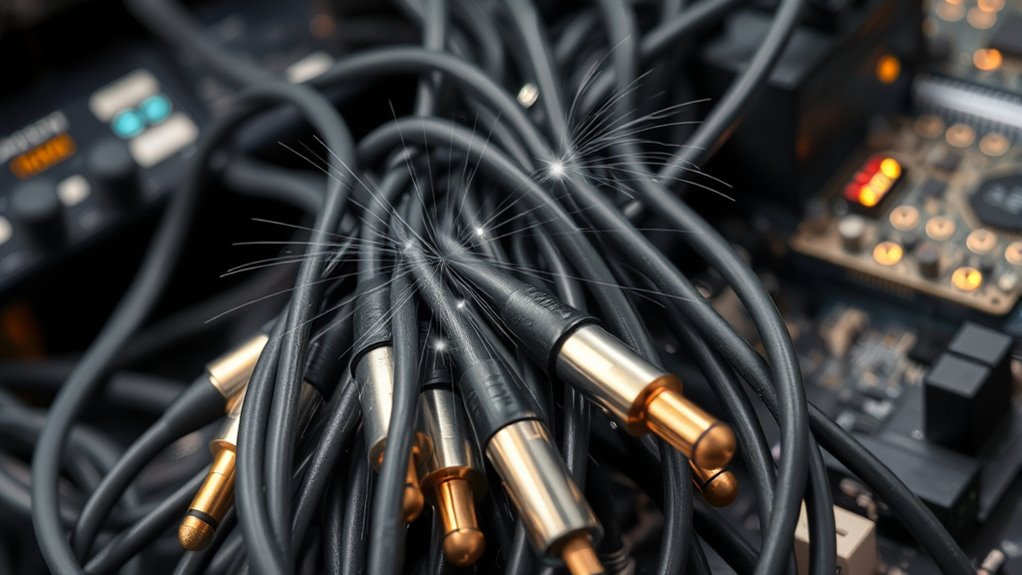
Electromagnetic interference (EMI) can notably degrade audio quality by introducing unwanted noise into your audio cables. When EMI affects your setup, you might notice persistent hums, buzzes, or static disrupting your sound. One common culprit behind these issues is ground loop problems, which occur when different pieces of equipment are connected to separate ground potentials. These loops create circulating currents that pick up electromagnetic noise, resulting in audible interference. To combat ground loop issues, you need to verify that all audio equipment shares a common ground reference, often achieved with ground lift adapters or by connecting everything to a single power strip. This simple step can considerably cut down on the hum caused by ground loops.
Ground loops cause hum and static; ensure all equipment shares a common ground to reduce interference.
Another critical factor influencing how vulnerable your audio cables are to EMI is shielding effectiveness. Good shielding acts as a barrier, preventing external electromagnetic fields from penetrating the cable and inducing noise. When your cables lack proper shielding or use inferior materials, they become more susceptible to electromagnetic interference, allowing noise to seep into your audio signal. To improve shielding effectiveness, opt for cables with braided or foil shielding, which provides better protection against EMI. Also, verify that the shielding is properly grounded, as ungrounded shields can sometimes serve as antennas, attracting more interference rather than blocking it.
The placement of your cables plays an essential role in minimizing EMI. Keep audio cables away from sources of electromagnetic fields, such as power supplies, transformers, fluorescent lights, or wireless devices. Crossing power cords and audio cables at right angles helps reduce induced noise, as perpendicular crossing minimizes the magnetic flux coupling. Additionally, using balanced audio cables with differential signaling can cancel out noise picked up along the cable, making your system more resilient against electromagnetic interference. Proper cable management and separation can further diminish susceptibility to EMI.
Finally, investing in quality cables with proven shielding effectiveness is worth the extra cost. Cheaper cables often lack proper shielding and are more prone to interference, especially in environments with high electromagnetic activity. Regularly inspecting your cables for damage or wear can also prevent noise issues. Damaged insulation or compromised shielding can allow EMI to infiltrate, leading to degraded audio quality. By paying attention to grounding, shielding, placement, and cable quality, you can greatly reduce the impact of electromagnetic interference on your audio system, ensuring cleaner, clearer sound with fewer disruptions. Additionally, selecting high-quality cables with robust shielding can provide long-term benefits in noise reduction.
Frequently Asked Questions
How Can I Identify Electromagnetic Interference in My Audio System?
You can identify electromagnetic interference in your audio system by listening for signal distortion, crackling, or humming noises. Ground loops often cause a persistent hum, especially when multiple devices are connected to different power sources. If you notice these issues, try disconnecting devices or using ground loop isolators. Moving cables away from power lines or electronics can also reduce interference, improving your audio quality.
Are Certain Materials More Resistant to Electromagnetic Interference in Cables?
A stitch in time saves nine. Certain materials do withstand electromagnetic interference better, especially those with superior material shielding and conductor composition. For example, cables with copper or silver conductors combined with braided or foil shielding offer enhanced protection. These materials help block external electromagnetic signals, preserving audio quality. Choosing cables with high-quality shielding and conductor composition ensures your system remains unaffected by interference, giving you clearer sound and peace of mind.
Does Electromagnetic Interference Affect Digital Audio Signals Differently?
Yes, electromagnetic interference affects digital audio signals differently than analog signals. Digital signals are more resilient because they rely on binary data, which can tolerate some interference without degradation. However, if shielding effectiveness is low, EMI can cause data corruption. While digital audio tends to be less prone to analog signal degradation, poor shielding can still introduce errors, so maintaining strong shielding is vital for clear, reliable digital audio transmission.
What Are the Long-Term Effects of EMI on Cable Performance?
Electromagnetic interference causes degradation over time in your cables, leading to reduced signal reliability. As EMI repeatedly impacts the cable, insulation and shielding can weaken, increasing susceptibility to noise and signal loss. Over extended periods, this deterioration can result in poorer audio quality and more frequent disruptions, making it essential to choose well-shielded cables and minimize EMI exposure to maintain performance and ensure consistent, high-quality sound transmission.
Can Electromagnetic Interference Cause Permanent Damage to Audio Equipment?
Like a shield protecting a knight, proper cable shielding prevents electromagnetic interference from causing permanent damage to your audio equipment. While EMI mainly results in noise or signal degradation, severe interference can sometimes harm delicate components. To avoid this, use high-quality cables with effective interference mitigation and guarantee proper grounding. This proactive approach helps safeguard your equipment, reducing the risk of long-term damage from electromagnetic interference.
Conclusion
If you ignore electromagnetic interference on your audio cables, you risk turning your pristine sound into a chaotic cacophony that could wake the dead! Every tiny electromagnetic wave can release a storm of noise, ruining your listening experience instantly. Protect your gear now, or prepare for a symphony of static and hums that will make even the bravest audiophile run for cover. Don’t let interference destroy your audio paradise—stand guard and keep your sound crystal clear!
